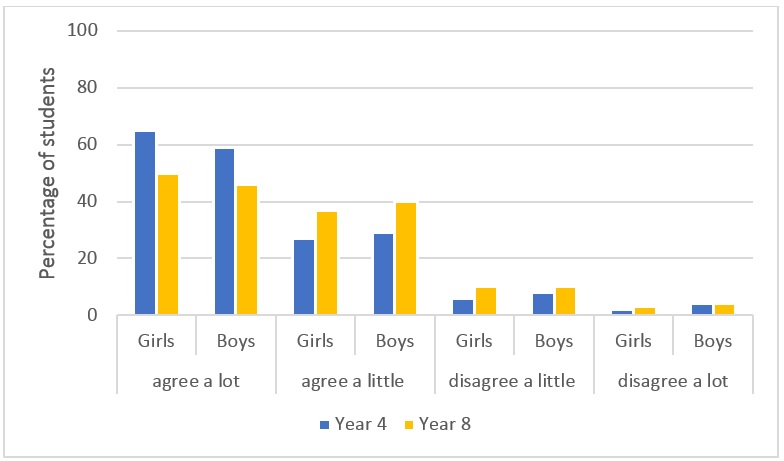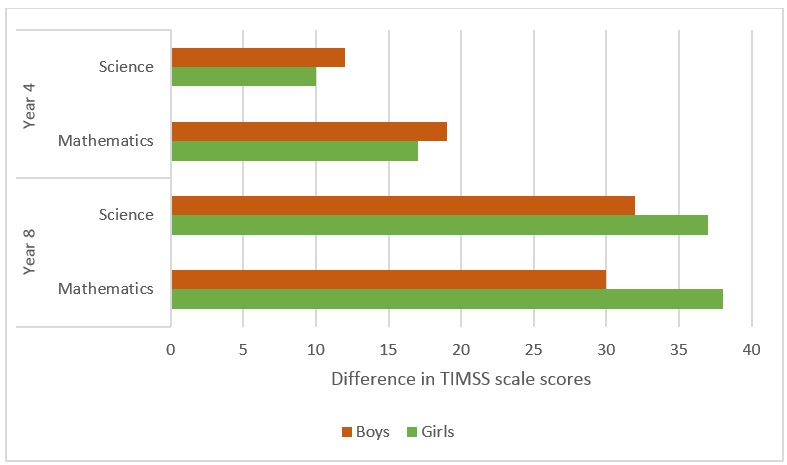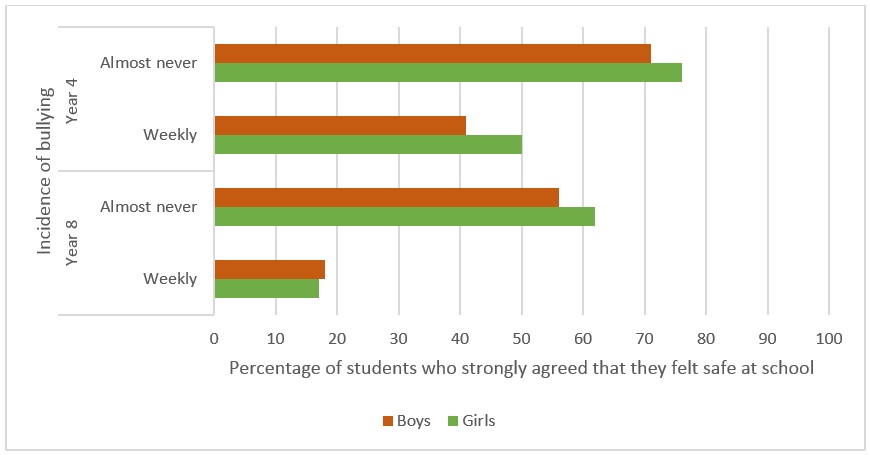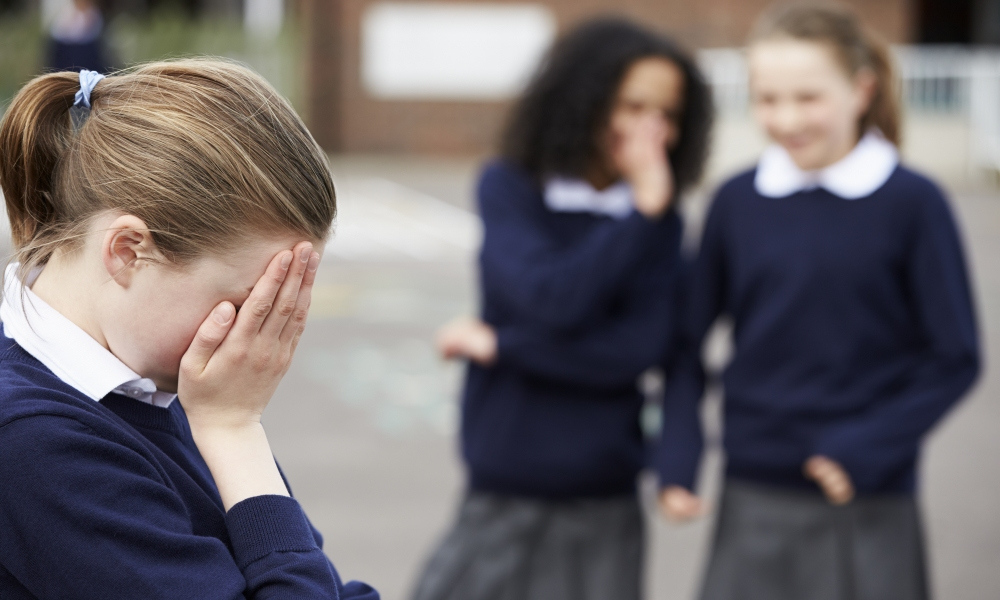Feeling safe at school – what does the research say?
Most people would argue that children should feel safe at school. For some children, school is possibly the only place in which they feel safe. However, when we see reports of school shootings and large-scale violence in school communities in other countries, we are reminded that this is not universal. On a more day-to-day level, bullying, and cyberbullying in particular, can significantly influence students' perceptions of school safety. However, the ramifications of bullying on students' levels of stress and wellbeing are not always considered as elements of school climate.
International reports have examined whether student perceptions of school safety are different for immigrant versus non-immigrant students (Chavatzia, Engel & Hastedt, 2016), by school setting (urban versus rural, Katschnig & Hastedt, 2017) and by gender (Prusinski, Hastedt & Dohr, 2019). This article looks at gender differences more closely for Australia and also examines the relationship with bullying. It asks three questions:
- What proportion of girls and boys feel safe at school?
- What relationships are there with achievement?
- What's the relationship with bullying?
To examine these questions, data from the Trends in International Mathematics and Science Study (TIMSS) have been used. TIMSS data include information not only about achievement, but also gender and student perceptions about a range of factors thought to be associated with achievement, such as school safety in this instance. At both Year 4 and Year 8, the TIMSS student questionnaire asked students to what extent they agreed with the statement 'I feel safe at school', with response options 'agree a lot', 'agree a little', 'disagree a little', and 'disagree a lot'. For the analyses presented in this article, the achievement and beliefs of students who 'agreed a lot' with this statement were contrasted with that of all other students. This created meaningful group sizes and enabled us to identify significant differences between those who felt very safe and those who did not.
What proportion of girls and boys feel safe at school?
On average, 59 per cent of Australian Year 4 students and 45 per cent of Australian Year 8 students strongly agree that they feel safe at school (a further 29 per cent of Year 4 students and 42 per cent of Year 8 students agree a little, which seems damning with faint praise). However there are significant gender differences in Australia, as in almost all of the other participating TIMSS countries.
In Australia at Year 4, 65 per cent of girls and 59 per cent of boys reported feeling 'very safe at school'. By the end of Year 8, these proportions had declined to 50 per cent of girls and 46 per cent of boys (Figure 1).

Figure 1. Level of agreement with the statement 'I feel safe at school'
What relationships are there with achievement?
Achievement was analysed in mathematics at both Year 4 and Year 8 for both groups of students. At Year 4, girls who agreed a lot that they felt safe at school achieved, on average, 17 score points higher in mathematics and 10 score points higher in science than those who felt less safe in school (achievement scales have a mean of 500 and a standard deviation of 100). For Year 4 boys, safety in school mattered a little bit more than it did for girls, with the differences 19 score points in mathematics and 12 score points in science.
At Year 8, the differences between students who felt very safe and those who felt less safe were larger, and were more evident for girls than boys. In mathematics, boys who reported feeling very safe at school outperformed their peers who did not report feeling the same level of safety by, on average, 30 points in mathematics and 32 points in science. However, girls who felt very safe at school scored, on average, 38 points higher in mathematics and 37 points higher in science than their peers. (Figure 2).

Figure 2. Differences in TIMSS achievement between students who feel very safe in school and those who feel less safe
What's the relationship with bullying?
TIMSS asked Year 4 and Year 8 students how often they experienced any of the following bullying behaviours:
- being made fun of or called names
- being left out of games or activities by other students
- having lies spread about them
- having something stolen from them
- being hit, shoved, kicked or otherwise hurt by other students
- being made to do things they didn't want to do by other students.
The most commonly reported forms of bullying in Australian schools were:
Year 4 students:
- Teased me or called me names (20 per cent)
- Left me out of games or activities (16 per cent)
- Spread lies about me (13 per cent) / Hurt me (12 per cent)
Year 8 students:
- Teased me or called me names (17 per cent)
- Spread lies about me (6 per cent)
- Hurt me / Left me out of games or activities (6 per cent)
When all of the bullying behaviours were considered together, 38 per cent of Australian Year 4 students reported almost never being bullied at school, the same proportion reported being bullied at school about monthly, and 25 per cent of students reported that this happened about weekly. The incidence of bullying seemed to decrease at Year 8 level, with 58 per cent of students reporting that they were almost never bullied, 31 per cent that they were bullied monthly and 11 per cent that they were bullied weekly. Of interest was the perception of being safe at school for those who report being bullied on a frequent basis (weekly) compared to those being bullied on an infrequent basis (almost never). It is likely that the relationship between the two is somewhat cyclical, however these data present one way of looking at the question.
At Year 4, 76 per cent of girls and 71 per cent of boys who report almost never being bullied also strongly agree that they feel safe in school (Figure 3). Of those bullied frequently, in this case on a weekly basis, the perception of safety at school is still fairly strong amongst primary school students, with 50 per cent of girls and 41 per cent of boys reporting a high level of safety at school.

Figure 3. Perception of safety at school in relation to incidence of being bullied
Bearing in mind the data from Figure 1 that told us that 50 per cent of girls and 46 per cent of boys at Year 8 strongly agreed that they felt safe at school, these data reveal that if students are rarely subject to bullying, 62 per cent of girls and 56 per cent of boys feel safe at school. On the other hand, for those students who are bullied frequently, school is no longer a place in which refuge can be sought, with only about 17 per cent of both girls and boys feeling safe at school.
Overall, Australian Year 4 students are more likely to have a strong belief in their safety at school than Year 8 students. At both year levels, on average, girls tended to feel safer than boys. As both girls and boys progress through school the academic achievement gap between those students who feel very safe in school and those who do not also tends to increase, but feeling safe in school appears to have a stronger relationship with academic achievement for girls than boys, and this increases as students move from primary to secondary school.
This analysis also points to a relationship between bullying and perceptions of safety. This link becomes stronger as students progress from primary to secondary school. If bullying is targeted specifically by schools then the proportion of students who feel safe at school could well increase.
References
Chavatzia, T., Engel, L.., & Hastedt, D. (2016). Where are the immigrant girls? (Policy Brief No. 12). Amsterdam, The Netherlands: IEA.
Katschnig, K. & Hastedt, D. (2017). Too scared to learn? Understanding the importance of school safety for immigrant students (Policy Brief no. 15). Amsterdam, The Netherlands: IEA.
Prusinski, E., Hastedt, D., & Dohr, S. (2018). Academic achievement and feelings of safety: A closer look at gender and grade level differences. IEA Compass: Briefs in Education No. 5. Amsterdam, The Netherlands: IEA.


